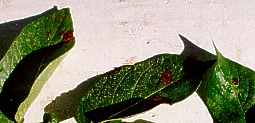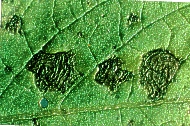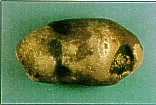

EARLY BLIGHT IN POTATOES


Early Blight lesions of leaves
Early Blight is caused by the fungus Alternaria solani and is present in all potato growing areas as a chronic but manageable disease. It overwinters in dead vines and leaves in the field and starts producing spores when the right temperature and moisture conditions occur. Spores are carried by wind, and can be found everywhere by the end of a season. Favorable weather conditions for spore production are alternating wet and dry periods over a wider range of temperatures than are tolerable to late blight (68 to 86 degrees F).
Blight lesions first show up as black spots on leaves and then enlarge, often developing a characteristic target appearance. Lesion expansion is often limited by leaf veins. A yellow halo may form around the lesions but this is not common in the early stages of the disease like in the case of late blight. Stem infection of early blight can occur after stress or hail, but this is a rare event.
Unlike late blight, this disease does not normally attack young, actively growing tissue. It attacks maturing portions of potato plants, potatoes under stress, and usually it shows up on the lower leaves. This is a disease of senescing plants. It thrives in plant parts with lower nitrate levels. As such early season early blight control can be very effectively managed by good plant nitrate levels. Late season is when fungicides become really important. Stress factors include poor nutrition, injury from hail and wind, insect damage, drought and diseases, especially PVY (Mosaic).
Since the fungus overwinters in dead tissue (unlike late blight which needs live tissue), multiple year potato rotations require more intensive early blight management. Potato cultivars vary in their susceptibility to early blight. Often resistance is associated with how cultivars mature. Norkotahs are very determinate and vine maturity occurs at a very specific time, at which point they suddenly become highly susceptible. Nuggets, on the other hand, are more indeterminate and keep growing vines all season, and they are less susceptible to blight. Over fertilized Nuggets will have very little problem with early blight while lower fertilizer levels now used on Nuggets have lead to more problems with early blight late season in Nuggets. This early death of vines due to early blight and maybe other factors can trim 50 cwt/A off the fields yield.
On of the biggest problems from the early blight fungus to the potato industry in the San Luis Valley is early blight tuber infection and decay. Severe losses can occur, especially in thinner skinned cultivars such as Century, Frontier, Ranger and Russet Burbank. Tuber infection by the early blight fungus occurs at harvest through wounds from bruises, immature tubers, and open lenticels. Any practice that reduces bruising, mature tubers at harvest and not harvesting in wet conditions vastly reduces tuber early blight decay since the fungus inoculum will always be present in vast quantities.

Management of tuber early blight involves preventing vines from blighting out, killing vines with sulfuric acid and being sure vines are totally dead by harvest and tubers are mature. A copper fungicide applied before harvest may help in preventing early blight tuber infection as well as flaming the soil, but proof of the effectiveness of these practices is not very conclusive yet.
Foliar blight can be managed early by light and frequent nitrogen applications, keeping the plants naturally resistant. Too much fertilizer late in the season can have the opposite effect, delaying tuber maturity and increasing tuber early blight infection. Fungicide management is critical late season on sensitive varieties. A degree day model available from the CSU Cooperative Extension Voice system (CEVIS) has been used in the San Luis valley to predict the beginning of early blight spore release. The model is: GDD=(Max temp-MIN temp)-45. When these GDD add up to 650-700 its time to think about early blight. There is also an interactive early blight model on the internet using Colorado weather information. To go to that site click here.
Early season most varieties have natural resistance and fungicides often are not needed. Even if a few lesions show up on the lowest leaves good plant nutrition and fungicides can keep the blight in check. Of course other stresses to the crop like over watering, weather and diseases can lead to problems with early blight. As always good disease management starts and ends with a strong plant which means total system management. Late blight management usually means early season fungicide applications so this early blight lower risk time cannot be taken advantage to save some input costs. As the plants begin to mature and the pressure builds late in the season, fungicide applications become necessary. Fungicide rotation is always a sound practice. Efficacy studies show that most chemicals work equally well as long as application intervals are adhered to. These studies usually look at individual chemicals in consecutive applications, and not at chemical rotations. Most fungicides work about the same with some with longer periods of effectiveness like chlorothalonil. Consult university studies for details of effectiveness of various fungicides. Coppers have the shortest life, but work very well in correcting copper deficiencies in potato crops which, if a problem, can lead to a stronger plant. Early blight can usually be controlled with a much less aggressive fungicide program than late blight.
Differences in efficacy of early blight control using aerial/ground rig versus chemigation application methods hasn't been observed in early blight. Every method has its advantages and disadvantages. Coverage is always important since fungicides applied for blight are only preventative and not systemic. Uncovered areas are susceptible.
| Ground Rig | Aerial | Chemigation |
| Expensive if custom applied
Leaves tracks in field Good coverage since flow rates can be high |
Expensive
Low flow rates Fungicide can concentrate on upper part of plant Misses in application can result in no control in areas |
Works well if application amount is
low - apply with fast machines of 8
-10 hrs/circle
Coverage of entire plant Inexpensive |
Note: This information should only be used as a guide. Adjustments for local conditions must always be made.